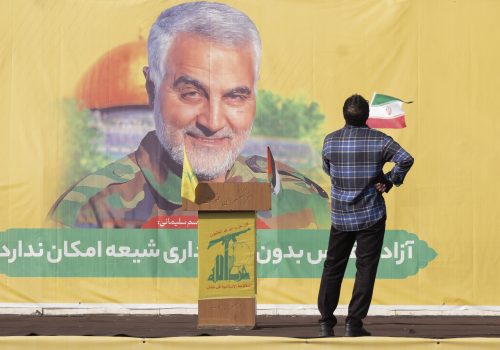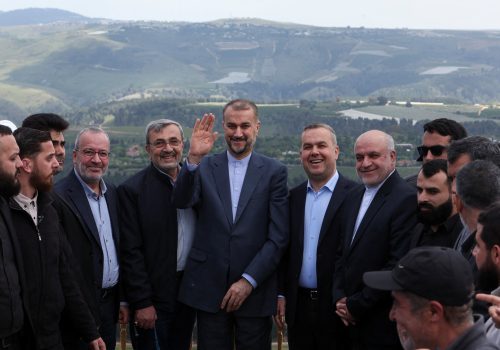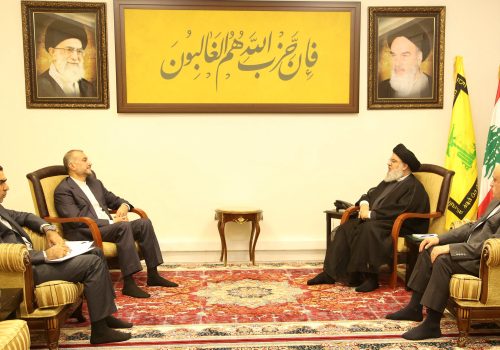Does the Resistance Axis believe its propaganda about Israel? The October 7 attack seems to suggest so.
A recurring television advertisement by Klil, an Israeli interior design company, claims that the terrorists “who tried to break, destroy, and upend” Israeli life on October 7 “do not understand the strength…of this country.” It’s a quaint message that is doubtlessly meant to bolster the nation’s morale, battered in that day’s horrendous attack. But the message seems implausible—that Hamas and its partners violated perhaps the fundamental rule of warfare in Israel without understanding the nature of their foe. Dissecting the background of the October 7 Al-Aqsa Flood attack suggests that may indeed have been the case.
The Resistance Axis’s perception of Israel is filtered through its worldview—a mixture of anti-colonialism and political Islam. The anti-colonial element explains Israel as a settler colonial entity artificially implanted by the West, particularly the United States, in the region and, therefore, inherently brittle or weaker than a spider’s web, in Resistance Axis parlance.
Israel, they claim, is not a real country but an American forward military base—a tool to carry out Washington’s regional designs. In addition, the Axis doesn’t view Jews as real people but as a mere religious group, and, therefore, sees Israeli Jews as lacking a genuine connection to each other and the land of Israel, which stands in contrast to the “indigenous” Palestinian—the rightful owners and natives of historical Palestine.
According to the Resistance Axis, the Zionists—aware of their alienness from the land and their “entity’s” artificiality—perceive the State of Israel as an exchangeable country and, thus, all have second passports and packed bags, ready to “return” to their real countries under the slightest pressure. To the Resistance Axis, a society aware of its unlawful presence in a land will not fight to remain as hard as the natives.
At this point, classical Islamic anti-Judaism steps in to describe the character of this society’s constituent components: individual Jews. Classical Islam portrayed Jews as fickle, scheming, wretched and abased, and—most significantly—cowards who will only fight “in fortified townships, or from behind walls,” if they fight at all. This ignominy—transferred into the Resistance Axis portrayals of Jews—contrasts with inherent Muslim heroism.
Thus, in a 2018 interview, Lebanese Hezbollah Secretary-General Hassan Nasrallah reiterated a longstanding claim: that the Israeli army is comprised of “defeated and cowardly” weaklings who “[lack] the will to fight” and will not even “take a step forward” unless cocooned by armor, ambulances, and airpower—a sharp contrast, he said, to the much braver Islamic State of Iraq and al-Sham (ISIS) fighters. In the Resistance Axis’s view, brittle Israel is sustained by two things: American support and the Israel Defense Forces (IDF’s) brutality—in contradistinction to military prowess—which provides Israeli society with a false sense of security.
The narrative’s utility
For the Resistance Axis, portraying Israel as a temporary entity comprised of cowards that will inevitably melt away—either under the alliance’s pressure or the weight of its internal contradictions—has an obvious utility, and is one that furthers the Axis goal of destroying the Jewish state.
Peace, the Resistance Axis claims, cannot be achieved with the inexorably evil Israel. “Resistance”—as a principle and conduct—is the only response to this rapacious, expansionist, and aggressive entity, whose raison d’etre is the murder of Arabs in the conquest of their lands—and whose mere existence is, therefore, inherently threatening to its neighbors. Resistance is the only way to regain Arab dignity and lands unjustly taken by the “usurper entity,” including all of Palestine “from the river to the sea,” per Nasrallah, which must be liberated and “restored to its rightful people” to correct history’s greatest moral wrong.
In this narrative, while neither conciliation nor even capitulation can quench Israel’s supposed voracious appetite for Arab blood or land, “resistance” works. To prove that, the Resistance Axis has redefined the very concept of victory to make its defeat impossible and insists that—since its inception as a military force rather than a mere principle—“the resistance” has been constantly and consistently victorious against Israel on a macro and micro level, moving inexorably toward Israel’s destruction through a thousand paper cuts until it can eventually deliver the final, mortal blow.
This narrative, which attracts massive support for “resistance” movements, would crumble if Resistance Axis supporters believed Israel to be a durable country, one whose citizenry—for all their differences—are a people with a genuine historical and irreplaceable connection to the Land of Israel.
Perhaps more than mere propaganda for the masses
Two pieces of increasingly conventional wisdom must be rebutted to understand how the dynamics of the October 7 attack suggest this perception of Israel—seemingly propaganda for the Resistance Axis base’s consumption—and how this infected the alliance’s military planning.
First, Al-Aqsa Flood was a collective Resistance Axis initiative, not a rogue Hamas operation. The attack unfolded exactly like Hezbollah’s long-standing threat to “liberate the Galilee”—a territorially limited incursion targeting border military installations and towns to kidnap and kill as many Israelis as possible and create a perception of victory—rather than conquer territory. This suggests that the Shia organization helped develop its operational blueprint. Credible reporting also indicates Iran provided approval, assistance, training, and oversight for the October 7 assault—most of which occurred in Lebanon, where Hezbollah, Iran’s longstanding conduit to Palestinian factions of the Resistance Axis, is dominant.
Hamas concealed the operation’s zero hour—compartmentalization, standard operational security in warfare—not to conceal the plan’s existence from Iran, Hezbollah, nor other Palestinian factions in Gaza, but more likely to deceive Israel regarding its timing.
Hamas barely succeeded at that, making it hardly plausible that it could have entirely excluded its intimate partners Iran and Hezbollah from knowing about the size and scale of Al-Aqsa Flood, whose plans were finalized by October 2022. The planning involved extensive intelligence gathering and at least two years of training, which was envisioned and unfolded as a disciplined and coordinated assault by fighters from several Palestinian Resistance Axis factions. Critically, this included Palestinian Islamic Jihad (PIJ), which, though a Sunni group, is deeply loyal to Iran and subscribes to its ordering principle of Velayat-e Faqih, making the notion of total Iranian ignorance even less conceivable.
The second notion is that Hamas was “surprised by its own success” on October 7. Evidence collected from the bodies of the assailants, the sheer number of fighters who broke through the Israeli border, and the amount and type of gear they were carrying suggests, if anything, that the October 7 attackers had intended a deeper incursion into Israel. Many were even carrying water-filled packs, which is unnecessary weight for a short incursion.
But the attack was supposed to serve converging Palestinian-Resistance Axis interests: torpedoing Saudi-Israeli normalization—a more dangerous undertaking than the Abraham Accords because it threatened to liquidate Palestinian maximalism gradually and, with it, Iran’s last avenue of establishing its desired preeminence over the majority non-Persian and non-Shia “Muslim world.” Simultaneously, since it’s unlikely the Resistance Axis sought to invite partial self-destruction, it’s more plausible they vastly underestimated the response of Israel’s military and its society.
On October 7, Israel had been in the throes of an unprecedented five-year political crisis, exacerbated by the Benjamin Netanyahu government’s judicial overhaul in 2022. The crisis had seemingly reopened every Israeli social fault line: Ashkenazim against Sephardim; religious against secular; Jews against Arabs; “First Israel” against “Second Israel”; etc. This induced critical numbers of IDF reservists and soldiers to refuse service and large numbers of Israelis to consider emigration, and eviscerated Israeli society’s confidence in Netanyahu’s leadership, even among Likud voters. One Kan Channel 11 commentator remarked how on Yom Kippur—a mere two weeks before the war’s outbreak—secular and religious Israeli Jews brawled in the streets of Tel Aviv’s Dizengoff Square over the placement of a mechitzah, the gender partition required by Jewish law during prayer.
It would seem the Resistance Axis genuinely read this upheaval as a manifestation of Israel’s inherent artificiality and the Israeli collapse they had long been predicting. Here, then, was their opportunity to accelerate Israel’s self-destruction by dealing the Jewish state a massive blow that would torpedo its last gasp at regional normalcy and destroy Israeli society’s sense of security by irreparably damaging the credibility of the IDF (their last consensus body)—all without incurring a commensurate cost.
This expectation only makes sense if the Resistance Axis believed Israeli society to be an artificial construct, with ties that bind no deeper than a superficial and waning commitment to unfounded Zionism. For only such a society could fail to muster the unity necessary to respond to an attack on the scale of Al-Aqsa Flood. Its inherent weakness would be compounded by the kidnapping of hundreds of hostages, putting this innately discordant society in the untenable position of trusting its reputationally battered leadership to both fight a costly war and make the tough moral choices regarding the hostages. The attack wouldn’t have caused Israel to collapse but to withdraw to proverbially lick its wounds after a brief military retaliation.
The anatomy of a misconception
Had the Resistance Axis accounted for the true nature of Israeli society and its national psyche, they may have expected Israelis to rally around the flag—even if temporarily—to destroy Hamas. For an alliance like the Resistance Axis, which boasts of its alleged intimate knowledge of Israeli society, this blindness appears perplexing. But this failure to understand an adversary’s society—consider the 2003 US invasion of Iraq or the 1982 Israeli invasion of Lebanon—is not so uncommon and, for all their bluster, the intelligence gathering apparatuses and methods of the Resistance Axis are much weaker than those of the United States or Israel.
Two factors likely underpinned this blindness. The first is that the Resistance Axis, being authoritarian, could not conceptualize domestic disagreement—irrespective of its intensity— through the lens of a democratic society like Israel. The inherent cacophony of democracy, viewed from Tehran, Dahiyeh, or Gaza City, could be confused for a society being pulled apart by its centrifugal forces. Thus, raucous domestic debate, even on historical inflection points, which is seen from a democratic society’s perspective as a sign of a society’s vibrancy and vitality, would easily be interpreted as an existential crisis and weakness from an authoritarian lens.
The second factor appears to stem from the Resistance Axis’ confusion between knowing their enemy and their motivations for loving them. As such, they do not interact with Israeli Jews and understand Israeli society through secondary means, instead selectively monitoring Hebrew media or gathering intelligence through sources of dubious reliability before plugging that information into a rigid ideological paradigm.
Confronted with such a colossal misreading of Israeli intentions after the 2006 Hezbollah-Israel War, Nasrallah uttered his now infamous “had I but known…” mea culpa. Perhaps the Resistance Axis—particularly its Palestinian franchises—are currently engaged in a similar reckoning.
David Daoud is a senior fellow at Foundation for Defense of Democracies (FDD) focusing on Hezbollah, Lebanon, and Israel.
Further reading
Wed, Nov 8, 2023
The Gaza war raises questions about the future of Iran’s Resistance Axis
IranSource By
The Gaza war presents the first significant test of the level of cooperation present among the elements of the Iran-led Resistance Axis.
Thu, Jul 6, 2023
Hezbollah and Iran have opened a fourth battlefront: Inside Israel
IranSource By David Daoud
Critical as recent developments may prove, they obscure a more dangerous Hezbollah initiative to establish a proxy foothold inside Israel.
Thu, Oct 19, 2023
Israel misread Iran’s way of war. A proper understanding could help predict Hezbollah’s next moves.
IranSource By David Daoud
Iran—through Hezbollah—has spent almost two decades and considerable effort and funds building the Gaza Strip into the Axis of Resistance’s Southern Front against Israel.
Image: A view of an Israeli flag and other belongings inside a burnt house that has been abandoned for two months after the deadly October 7 attack by gunmen from Palestinian militant group Hamas from the Gaza Strip, in Kibbutz Beeri, southern Israel, December 7, 2023. REUTERS/Athit Perawongmetha


